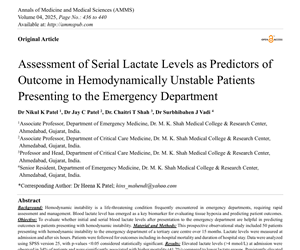Assessment of Serial Lactate Levels as Predictors of Outcome in Hemodynamically Unstable Patients Presenting to the Emergency Department
Authors
##plugins.themes.bootstrap3.article.main##
Abstract
Background: Hemodynamic instability is a life-threatening condition frequently encountered in emergency departments, requiring rapid assessment and management. Blood lactate level has emerged as a key biomarker for evaluating tissue hypoxia and predicting patient outcomes. Objective: To evaluate whether initial and serial blood lactate levels after presentation to the emergency department are helpful in predicting outcomes in patients presenting with hemodynamic instability. Material and Methods: This prospective observational study included 50 patients presenting with hemodynamic instability to the emergency department of a tertiary care centre over 15 months. Lactate levels were measured at admission and after six hours. Patients were followed for outcomes including in-hospital mortality and duration of hospital stay. Data were analyzed using SPSS version 25, with p-values <0.05 considered statistically significant. Results: Elevated lactate levels (>4 mmol/L) at admission were observed in 34% of patients and were significantly associated with higher mortality (41.2%) compared to lower lactate groups. Persistently elevated lactate levels at six hours were also linked to poorer outcomes. Patients with higher lactate levels showed significantly lower systolic blood pressure, higher heart and respiratory rates, and lower oxygen saturation at admission. Length of hospital stay was significantly longer in patients with elevated lactate levels. Conclusion: Elevated admission and persistent lactate are significantly associated with increased mortality and prolonged hospital stay in hemodynamically unstable patients. Serial lactate monitoring serves as a valuable prognostic tool to guide early intervention and improve outcomes in emergency settings.
##plugins.themes.bootstrap3.article.details##
Copyright (c) 2025 Dr Nikul K Patel, Dr Jay C Patel, Dr. Chaitri T Shah, Dr Surbhibahen J Vadi

This work is licensed under a Creative Commons Attribution 4.0 International License.
Creative Commons License All articles published in Annals of Medicine and Medical Sciences are licensed under a Creative Commons Attribution 4.0 International License.
[1] Cecconi M, De Backer D, Antonelli M, et al. Consensus on circulatory shock and hemodynamic monitoring. Intensive Care Med. 2014;40(12):1795-815.
[2] Vincent JL, De Backer D. Circulatory shock. N Engl J Med. 2013;369(18):1726-34.
[3] Andersen LW, Mackenhauer J, Roberts JC, Berg KM, Cocchi MN, Donnino MW. Etiology and therapeutic approach to elevated lactate. Mayo Clin Proc. 2013;88(10):1127-40.
[4] Bakker J, Nijsten MW, Jansen TC. Clinical use of lactate monitoring in critically ill patients. Ann Intensive Care. 2013;3(1):12.
[5] Nguyen HB, Rivers EP, Knoblich BP, et al. Early lactate clearance is associated with improved outcome in severe sepsis and septic shock. Crit Care Med. 2004;32(8):1637-42.
[6] Jansen TC, van Bommel J, Schoonderbeek FJ, et al. Early lactate-guided therapy in intensive care unit patients: a multicenter, open-label, randomized controlled trial. Am J Respir Crit Care Med. 2010;182(6):752-61.
[7] Puskarich MA, Trzeciak S, Shapiro NI, et al. Prognostic value of initial lactate and lactate clearance in ED patients with severe sepsis and septic shock. Crit Care Med. 2013;41(2):282-9.
[8] Levy MM, Evans LE, Rhodes A. The surviving sepsis campaign bundle: 2018 update. Intensive Care Med. 2018;44(6):925-8.
[9] Odom SR, Howell MD, Silva GS, Nielsen VM, Gupta S, Shapiro NI. Lactate clearance as a predictor of mortality in trauma patients. J Trauma. 2013;74(4):999-1004.
[10] Kruse O, Grunnet N, Barfod C. Blood lactate as a predictor for in-hospital mortality in patients admitted acutely to hospital: a systematic review. Scand J Trauma Resusc Emerg Med. 2011;19:74.
[11] Soliman HM, Vincent JL, Machiels JP, et al. The impact of hyperlactatemia on ICU length of stay and mortality. Crit Care. 2010;14(1):R1.
[12] Hayashi Y, Morimatsu H, Matsuda T. The clinical importance of a high blood lactate concentration at admission in the intensive care unit. Anesth Analg. 2014;119(3):570-5.
[13] Masyuk M, Wernly B, Lichtenauer M, et al. Prognostic relevance of lactate clearance in critically ill patients: systematic review and meta-analysis. Intensive Care Med. 2019;45(4):484-91.
[14] Shalaby A, Sayed A, El-Dahshan K, et al. Correlation of serum lactate level with oxygenation and outcome in critically ill patients. Egypt J Chest Dis Tuberc. 2016;65(1):157-63.
[15] Bernhard M, Becker TK, Gries A, et al. Admission lactate concentration in critically ill patients as a predictor of 30-day mortality: a retrospective cohort study. Eur J Anaesthesiol. 2018;35(7):595-602.

